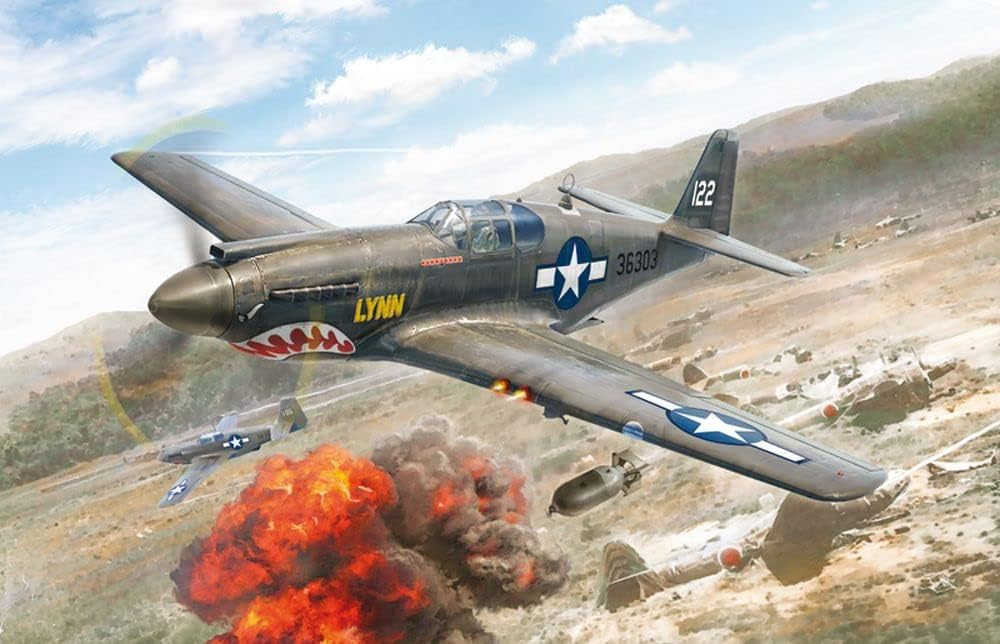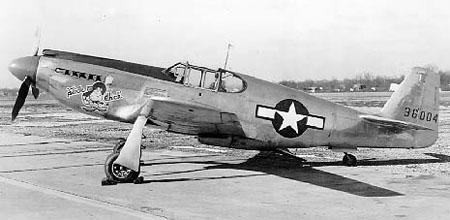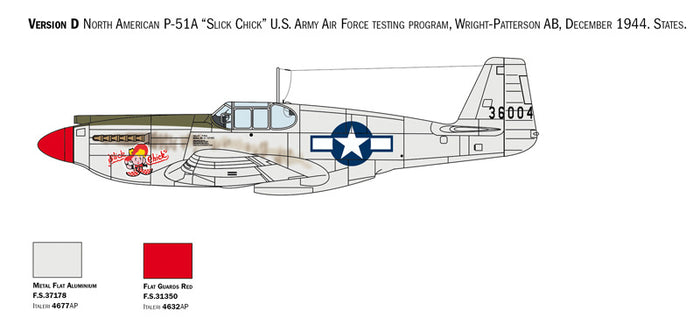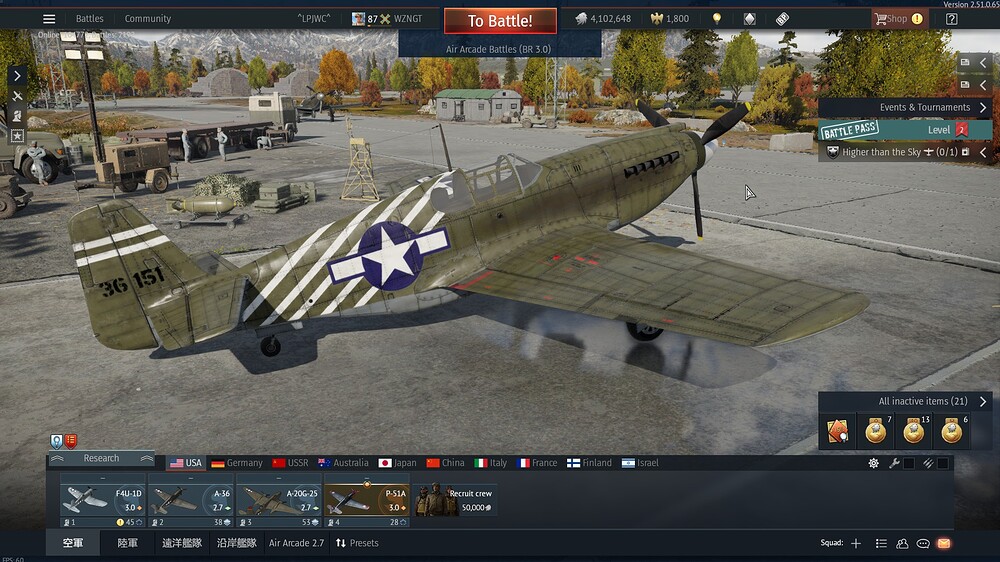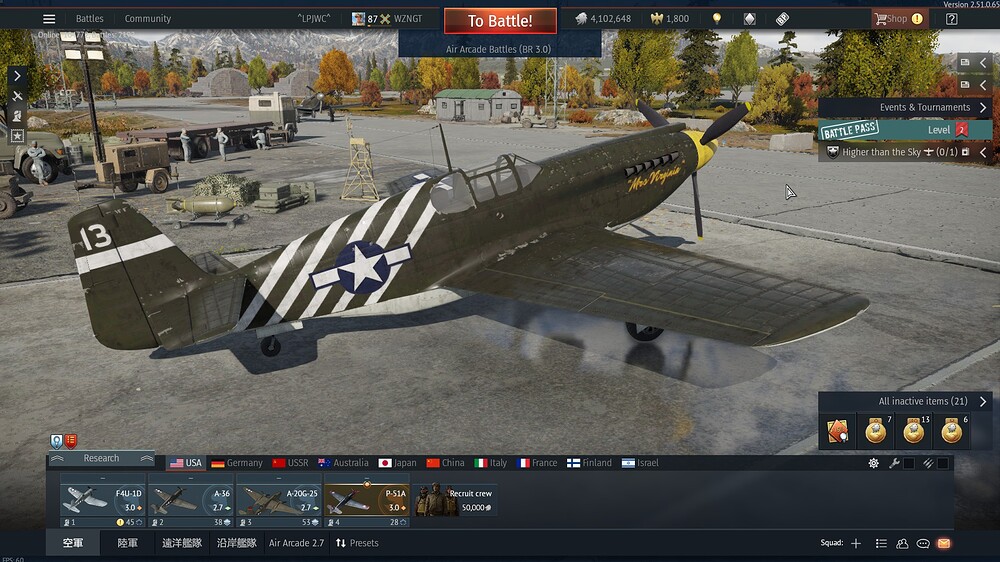History
Background
The P-51A, with company model designation NA-99, was derived from the original RAF Mustang I (NA-73/-83/-91). Essentially an A-36 without dive-bombing equipment and nose guns, its armament was reduced to four wing-mounted 0.50-caliber machine guns. It retained the A-36’s fixed cooling-air scoop but added an L-shaped pitot probe under the wing, a feature later seen on all fighter Mustangs. The aircraft had a single landing/taxi light instead of the A-36’s dual unit.
Powered by the uprated Allison V-1710-81 engine with a more efficient single-speed, single-stage supercharger, the P-51A offered better high-altitude performance than the cannon-armed P-51/Mustang I or A-36. This improvement boosted its rate of climb, service ceiling, and top speed (now 409 mph/658 km/h at 10,000 ft/3,000 m). While its performance still fell short of the P-38 with V-1710s and subsequent Merlin-powered Mustangs, and its flight characteristics proved inferior to Spitfires and Messerschmitts in high-altitude dogfights, the AAF School of Applied Tactics at Orlando, Florida, rated it as the best USAAF fighter below 22,000 feet. The P-51A became the final Allison-engined Mustang variant.
Production
In December 1942, the Army ordered 310 P-51As under a revised contract. An original August 1942 order for 1,200 aircraft was reduced after the USAAF opted to mass-produce the superior high-altitude Merlin-powered P-51B following its first flight in November 1942. Fifty P-51As from the 310-aircraft order were sent to the RAF as Mustang IIs, replacing lost and aging Mustang Is.
P-51A production comprised three (technically four) blocks:
-
43-6003/6102 → P-51A-1-NA
-
43-6103/6157 → P-51A-5-NA
-
43-6158/6312 → P-51A-10-NA
The P-51A-1 featured a carburetor air scoop providing direct ram air. The P-51A-5 added a retractable filter in the scoop, a landing gear warning light, and provisions for chemical tank installation. The P-51A-10 incorporated all P-51A-5 features plus a carburetor heating duct. The P-51A-2 designation applied to field-upgraded earlier models brought to this standard.
The prototype P-51A first flew on February 3, 1943, with deliveries beginning in March. These aircraft arrived in olive drab over gray schemes. The first operational models reached the 54th Fighter Group at Bartow Army Field, Florida, where pilots trained on the new type.
Arrival in China-Burma-India Theater
Most remaining P-51As were deployed overseas, primarily to the China-Burma-India theater. The 311th Fighter Group, then operating A-36As, became the first combat unit to receive P-51As in mid-1943. Based in India, the group supported Allied operations against Japanese forces in Burma. Its 528th and 529th Squadrons flew A-36s, while the 530th operated P-51As.
The transition from A-36 to P-51A proved straightforward for pilots and ground crews. The group used P-51As for transport and bomber escort alongside A-36s. The improved P-51A excelled in these roles, capable of carrying 75 or 150 US gallon drop tanks that extended its maximum range to over 2,700 miles (4,345 km) at reduced power.
In September 1943, the 23rd Fighter Group - formed from remnants of the disbanded “Flying Tigers” AVG - began transitioning from P-40Es and A-36s to P-51As. Unlike the 311th’s long-range escort missions, the 23rd employed its P-51As primarily for fighter sweeps.
The 311th FG’s first major operations began on October 16, 1943. One significant mission was on November 23, 1943, when eight P-51As from Lieutenant General Chennault’s 23rd FG, with 8 P-38s joining in, flew on a rare escort mission to escort 14 B-25s raiding the Japanese airfield at Shinchiku (now Hsinchu), Taiwan.
Another significant mission was like this when, on November 25, 1943, the P-51As of 530th Fighter-Bomber Squadron of the 311th Fighter Bomber Group flew on long-range escort mission to escort B-24 Liberators in an attack on Mingaladon Airfield in Rangoon, Burma, with a round trip accounted nearly 900 miles (1,450 km) from Kurmitola, India, to Rangoon in Burma in a span.
P-51As frequently encountered Ki-43 Oscars from the experienced 64th Sentai during B-24 escort missions. While superior to P-40s and P-38s at low/medium altitudes, P-51As struggled against the more maneuverable Oscars at higher altitudes. Early combat losses prompted tactical changes after December 1943. Pilots of the P-51As were ordered to avoid turning fights and instead make high-speed passes, maintaining speed to disengage and reposition. This was an old tactic long used by P-40 pilots.
As Allied fortunes improved in 1944, the 311th became increasingly offensive. That spring, A-36s and P-51As of the 311th FG attacked Japanese forces throughout central Burma, including major strikes on Meiktila airbase. In July 1944, they supported Merrill’s Marauders (a US Army long-range penetration special operations unit known for their audacious missions deep behind enemy lines in Burma) with close air support missions.
1st Air Commando Group
The 1st Air Commando Group (ACG) became another notable P-51A operator in the CBI theater. This pioneering composite unit, combining reconnaissance and close air support, operated from improvised jungle airstrips to support Indo-British Chindit operations in Burma, where the Chindits performed their long-range penetration missions.
On February 14, 1944, ACG P-51As flew their first combat mission, escorting B-25Hs attacking Zaundaing. Despite losing two P-51As and suffering three damaged to 50th Sentai Oscars, the group flew over 70 sorties that day against various targets. As experience grew, ACG pilots gradually gained the upper hand against Japanese air units.
Throughout March-April 1944, ACG P-51As relentlessly attacked Japanese communications and transport. Configured with a rare and overweight payload of two 1,000-lb bombs and triple rocket tubes, they delivered impacts on Japanese offensive capabilities during the April 1944 push toward India. The group’s P-51As claimed ten aerial victories plus numerous ground kills before withdrawing for reorganization on May 19, 1944, after 230 missions.
Reconnaissance in Europe
Far from the CBI theater, 35 of 310 P-51As were converted to F-6B reconnaissance aircraft by adding K-24 cameras behind the cockpit. The 107th Tactical Reconnaissance Squadron (67th TRG) at Middle Wallop, England, became the primary, possibly only, F-6B operator, receiving its first aircraft in October 1943.
From December 1943, F-6Bs conducted wide-ranging reconnaissance over northern France. After D-Day, they relocated to northern France, continuing operations until being gradually replaced by Merlin-powered reconnaissance Mustangs, though some F-6Bs remained in service well after the invasion.
Phaseout
In the CBI theater, P-51As gradually replaced P-40s as the primary US fighter during 1944, though the transition progressed slowly due to the theater’s low priority for newer aircraft. Remarkably, P-51As remained operational into 1945 despite the arrival of Merlin-powered Mustangs. With 1,580 Allison-engined Mustangs built before production ended in the summer of 1943, these aircraft played a vital combat role until superseded by their more famous Merlin-powered successors.










